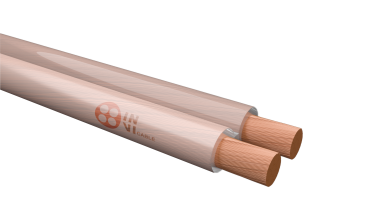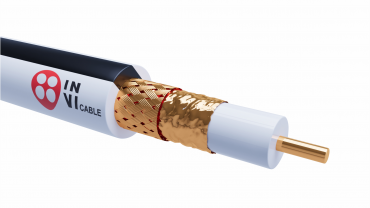Coaxial, speaker and CCTV camera cables
COAXIAL CABLES
The term coaxial comes from the design of an inner and outer conductor (screen) having the same axis. Coaxial cables were originally developed for radio frequency (RF) and microwave transmission. The signal is transmitted along the cable at high frequency in the form of a wave and is directed along the conductors. And due to the same direction of the axes, electromagnetic fields are concentrated between the conductors, which protects against external radiation and reduces internal losses.
Such a cable typically consists of a solid copper (or copper-clad steel) core for signal transmission, covered with successive layers of internal insulation, aluminum foil, copper braided mesh, and external protective insulation. Solid wire provides better conductivity than stranded wire, but is less flexible and difficult to install. Insulation - usually PVC (polyvinyl chloride) or non-stick coating, aluminum foil and copper mesh provide shielding to the inner core. The mesh also provides a grounding point for the cable completing the circuit.
Currently, RG coaxial cables are produced by many manufacturers, which is why there is a very wide variety of shapes, sizes, and technical characteristics of these products. The most common types of coaxial cables are:
- RG-6 is a standard television cable with a characteristic impedance of 75 Ohms. The Russian analogue is RK-75;
- RG-11 – is a trunk cable with increased external insulation, used for transmitting signals over long distances;
- RG-59 – thin television cable with a resistance of 75 Ohms, used over short distances.
All of the cables mentioned contain the letters RG in their names, which stand for radio guide (translated into Russian as radio frequency waveguide). The numbers indicated in the cable brand indicate its type. Although each coaxial cable has its own number, size and characteristics, they all have the same design and operating principle. The higher the RG number, the thinner the center conductor core. 75 ohm cables are primarily used for video signals, while 50 ohm cables are typically used for data and wireless communications.
SPEAKER CABLES
Speaker cable is a type of electrical cable that is used to make the electrical connection between speakers and audio amplifiers.
The speaker cable is used to transmit the audio signal in various audio systems. The characteristics of the latter are frequency and amplitude. Using ordinary household speakers as an example, these parameters mean the following. Higher frequency means we hear higher sounds. Low frequencies are responsible for bass. The loudness of the sound depends on the amplitude. Unlike electrical wires, sound wires carry a small current.
The main function is to transmit electric current with minimal losses. However, in this case the signal is a carrier of information. Sound.
Modern speaker cables consist of two or more electrical conductors (cores) insulated with insulation such as PVC, polyethylene or Teflon. High grade copper is preferably used as the conductor material.
CCTV CAMERA CABLES
A signal cable is a high-strength wire for carrying all kinds of signals: alarm, audio, control, measuring, as well as video signals, etc. The most popular today are signal wires for security systems. The main function of such a cable is to connect security devices in low-current systems. A signal cable is a wire consisting of several pairs of insulated conductors covered with a sheath.
Due to its high flexibility, the cable has wide possibilities for laying and installing lines, with the possibility of fastening at an angle and laying in plastic pipes.
The use of wear-resistant and durable materials guarantees a long service life over a wide temperature range. The PVC shell is resistant to moisture and most aggressive substances. Subject to safety standards, the cable ensures reliable data transmission and high-quality operation of complex systems.
The following types of signal cables are distinguished:
- Symmetrical, have pair twisting and are used in fire safety systems;
- Signal flexible wire. First of all, it is necessary for connecting various mobile mechanisms to electrical networks, and it is also used in conditions of low and high temperatures, since this has almost no effect on the operation of the product. It is also used for the formation of control and alarm systems, automation of technological processes and industrial interfaces. This type of wire is noted for its high performance and durability;
- Cable for digital PBX and telephony, computer local networks, its difference is in scalability at all levels;
- Coaxial cable, it is used for satellite TV and subscriber networks;
- RF coaxial cable, it is used to transmit radio signals, this type of wire is very resistant to atmospheric pressure fluctuations, vibration and heavy loads.





